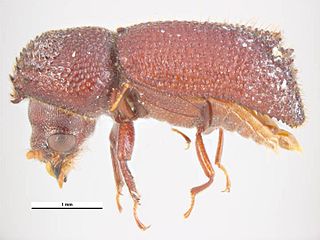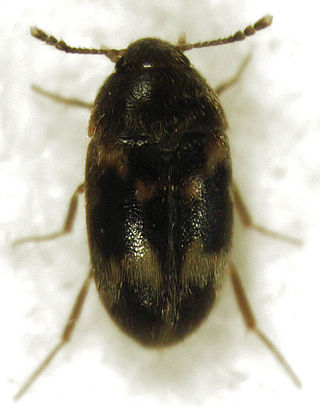This article needs additional citations for verification .(March 2007) |
| Variegated mud-loving beetles Temporal range: | |
|---|---|
 | |
| Heterocerus novaeselandiae | |
| Scientific classification | |
| Domain: | Eukaryota |
| Kingdom: | Animalia |
| Phylum: | Arthropoda |
| Class: | Insecta |
| Order: | Coleoptera |
| Suborder: | Polyphaga |
| Infraorder: | Elateriformia |
| Superfamily: | Byrrhoidea |
| Family: | Heteroceridae MacLeay, 1825 |
Heteroceridae, the variegated mud-loving beetles, are a widespread and relatively common family of beetles found on every continent except for Antarctica.
Contents
Around two hundred and fifty species of heterocerids are known to occur worldwide. [1] They are most diverse in tropical and sub-tropical regions. Currently, 87 species are known from the New World, [2] including 34 from the United States. [3]
Variegated mud-loving beetles are brownish, dorsoventrally depressed shoreline inhabitants. Superficially they resemble small scarabs with the tibiae armed with rows of robust flattened spines. The beetles live in shallow tunnels that they dig in damp soil around fresh and brackish lakes, rivers and ponds. Heterocerids have been reported to live in intertidal sandflats [4] and on remote oceanic islands. [5] The uniform way in which they live seems to have favored the conservation of a "phenotypical uniformity in external morphology". [6] Consequently, it is often quite difficult to identify one of these beetles to species relying on external morphology alone. Therefore, male genitalia are most often relied upon to identify species. Although few studies have been conducted on their ecology, heterocerids have been shown to be an important prey group for passerine birds and frogs (Schmidt et al., 2003; Turner, 1959), and they appear to play a significant role in seed dispersal and burial in sandy soils. [7] They are thought to be detritivores, consuming the substrate to sift for organic matter, microorganisms, and algae. [5]
In the most recent revision of the family, Francisco Pacheco (1964) split the heterocerids into 20 different genera, erecting 17 new generic names based almost entirely on the features of male genitalia. Most systematists have found Pacheco's system complex and impractical because the ratio of genera to species is high and females cannot be identified. Consequently, his generic circumscriptions have not been widely accepted. [8]










